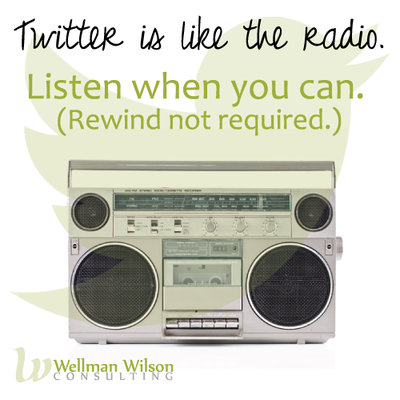 I’m driving a different car these days. My borrowed car is low tech and forces me to listen to the radio *gasp* if I want to listen to anything on my commute. I’m used to plugging in my iPod and listening to what I want, when I want. I can rewind, fast forward and skip around to my little heart’s content.
I’m driving a different car these days. My borrowed car is low tech and forces me to listen to the radio *gasp* if I want to listen to anything on my commute. I’m used to plugging in my iPod and listening to what I want, when I want. I can rewind, fast forward and skip around to my little heart’s content.
But in rediscovering the radio, I’m practicing my listening and observing skills in a different way.
The funny thing is that old media meets new media in a really interesting way because the radio reminds me so much of Twitter!
1) They promote.
Some stations (accounts) run promotions - whether it’s their content or advertising from other businesses.
2) They have conversations.
Think about morning DJs that banter through the rush hour traffic between commercials, news and music. The social aspect of these discussions starts in the studio and extends outwards to callers who join in. (Sounds an awful lot like people who jump in on Twitter.)
3) They share.
It’s balanced sharing, too - human interest stories, community events, news, and all sorts of other really great content that the audience might find interesting or - even better - want to hear and know about.
4) They inspire action.
I think what I like best about listening to radio is hearing really creative commercials. There’s the usual car dealership commercials that sound the same as they’ve sounded my entire life, but other businesses are getting really creative and clever. It worked, too! I was interested in going to a couple of businesses I hadn’t previously even heard of.
Radio is a finite interaction.
Lara has used this analogy of “Twitter is like a radio” for a long time. It helps newer users understand that they don’t have to read every tweet sent when they weren’t logged in and it’s true. Radio doesn’t allow you to pause, fast forward, or rewind - a lot like Twitter.
However, there’s a difference with interactions. Radio is primarily one-sided and finite. You turn it off and you can’t go back and listen to what you’ve missed later.
Twitter allows you to come and go, picking up the thread of conversations as you have time. BUT you don’t have to read through everything that everyone you’re following has said while you’re logged out. And thank goodness for that, because that would be incredibly overwhelming.
The bottom line is that old media and new media influence each other. You can find inspiration from one that can be used successfully with the other. The most important thing is to evolve and be creative. Find unique ways to grab your audience’s attention.





 There's been a fair amount of talk in the last week about
There's been a fair amount of talk in the last week about 






